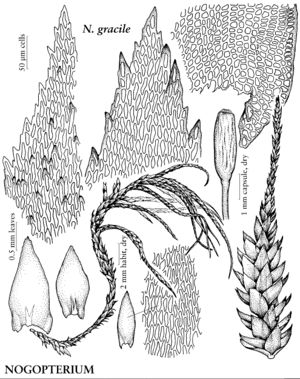Nogopterium
Novon 21: 424. 2011.
| Taxon | Illustrator ⠉ | |
|---|---|---|
 | Nogopterium gracile | Patricia M. Eckel |
Plants somewhat large, in coarse mats, yellow-green to brownish, dull. Stems pinnate. Stem-leaves ovate; base cordate, slightly decurrent; margins inflexed proximally, plane distally, serrulate proximally, serrate distally; apex acute; ecostate or costa double, ending below mid leaf; alar cells oblate to rounded, region extending 1/2 margins; laminal cells prorate, especially distally; medial cells linear-rhomboidal; apical cells shorter. Branch leaves similar. Specialized asexual reproduction absent. Perigonia unknown. Perichaetia acicular in axils of branches, leaves imbricate, elongate, base sheathing, apex acuminate. Seta short-to-elongate. Capsule exserted, cylindric; annulus deciduous; operculum conic; exostome teeth linear-lanceolate, horizontally striolate basally, with vertical or oblique lines distally, weakly papillose at apex; endostome basal membrane low, segments linear, weakly papillose.
Distribution
w North America, South America (Brazil), Europe, Asia, Africa, temperate regions
Discussion
Species 3 (1 in the flora).
The name Nogopterium replaces the long-used Pterogonium Swartz, which is illegitimate. Characters important for Nogopterium are broad, acute and serrulate leaves, with costa absent or double and short (below mid leaf), and laminal cells papillose distally by projecting cell ends on abaxial surface.
Selected References
None.